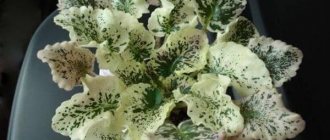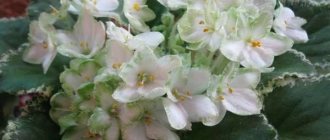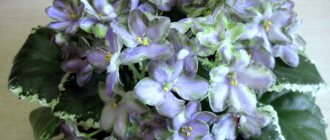Saintpaulias are coming back into fashion and turning the idea of cute blooming violets that willingly live on any windowsill. Trends in the “market” for Uzambara violets indicate a rapid increase in interest in plants with unusual leaves. More and more admiring glances are attracted not by the unusual colors of flowers, but by the exotic variegated colors of the leaves. Variegated Saintpaulias are almost no different from all the others in cultivation. But bright flashes of light spots on the leaves completely transform their appearance.
Saintpaulia 'Rob's Outer Orbit'. © N. Pomazova
What kind of leaves do Saintpaulias have?
Violets are often called indoor plants, the most diverse in terms of flowering parameters and the most boring in terms of greenery. For some reason, all Saintpaulias are perceived as dark-leaved, velvety-leaved, neatly rosette crumbs. But if you take a closer look not only at the flowering, but also at the greenery, it is obvious that each variety’s leaves are actually special.
More rounded or oval, almost heart-shaped or narrow, with a wide base or a narrow petiole, raised or almost recumbent, small, medium and large, with varying degrees of jagged edges, different shades of green color and the effect of their fluffing...
All Saintpaulias are individual and unique. But by “special leaves” of violets they usually mean either plants with ruffles along the edges (beautiful wavy varieties) or newfangled variegated leaves of the selection.
Unlike the extravagant collectible leaf violets, which bloom inconspicuously and are grown only for their leaves, variegated violets are full-fledged and familiar Saintpaulias, in which variegated leaf colors are added to the “option” of luxurious flowering.
Saintpaulia 'Lucky Penny'. © Mildred Rosam
Varieties and series of variegated Saintpaulias
There are a huge number of fans of variegated Saintpaulias in the world, and breeders create entire series. The most famous are Buckeye (P. Hancock), Apache (J. Munk). Modern Russian and Ukrainian breeders (N. Puminova, K. Morev, S. Repkina, E. Lebetskaya, E. Korshunova) also pay special attention to the breeding of variegated varieties. New selections amaze with previously incompatible traits: fancy, densely double, green-flowered varieties, and all this - on a rosette that seems to be dusted with snow. A. Patyanina, collector of Gesneriaceae, Sarov, made a special contribution to the classification of Saintpaulias according to types of variegation.
Saintpaulia Tinker Bells
Leaf variegation is a unique mutation of Saintpaulias.
Variegated foliage is an atypical phenomenon for Uzambara violets, but it is not exactly an achievement of science. These are natural genetic mutations that reduce the amount of chlorophyll in the cells of certain areas of the leaves and, in fact, disrupt the metabolic changes typical of Saintpaulia.
The possibility of breeding variegated varieties was discovered thanks to an amazing random mutation in one of the largest collections of violets in the United States. Natural mutation remains the main tool for obtaining these unique multi-colored violets today. And selection, which strengthens and enhances variegation in offspring, allows us to obtain different variations of variegated patterns.
The variegation of Saintpaulias - the “value” is not constant. The best variegated varieties in other conditions can completely lose light and colored areas or, conversely, increase their area. Dependence on the quality of care and stability of conditions are the factors that determine the manifestation of this mutation on the leaves of the plant.
Variegated Saintpaulias are attractive because, unlike many other plants, each mutation is completely unique. In fact, variegation is exclusive to each plant. Their leaves can become colored from both the edges and petioles, change patterns throughout the aging process, offer different variations of patterns on each leaf and are not repeated exactly once.
Groups of variegated violets
Depending on how the patterns appear not only on individual leaves, but also on the entire rosette, all variegated Saintpaulias are divided into several groups:
- Mosaic varieties (trade name Lilian Jared), in which variegation appears in the center or at the base of the leaf blades in the form of alternating spots, reminiscent of mosaics or marble patterns.
- Bordered varieties (trade name - Tommie Lou) are neat and beautiful Saintpaulias, on the leaves of which light edges appear along the edges and seem to blur, without creating a strict effect.
- Crown varieties (trade name - Champion), in which the variegation decreases from the center of the rosette to its edges, sometimes almost disappearing on the lowest leaves and always appears differently on each leaf - from small specks similar to dust particles to large spots, from rare points until they cover almost the entire leaf plate evenly or cover it completely.
- Chimeric mutations are the appearance of large spots on the leaves of a different shade of green, usually in the center of the leaf.
- Spontaneous mutations occurring in varieties without previously characteristic variegation.
Mutations during vegetative propagation are completely preserved in variegated violets, but with one secret: the cleaner the leaf used for cuttings, the stronger the patterns on the offspring and the stronger the plants themselves.
The most striking variegation in the offspring can be observed if you use non-variegated leaves from the second row in the rosette - from the bottom, of course.
But getting new bushes is not easy: due to mutations, the small, almost white rosettes that form on old leaves during rooting become much more fragile and weaker than those of ordinary Saintpaulias. You can separate them from the cuttings only when they have grown well and dark green colors appear on the young rosettes.
Saintpaulia 'Powwow'. © catfootfog
ANALYSIS OF VARIETITY OF VIOLETS. MODERN TYPES OF VARIETICITY.
7 messages
In the distant fifties (already the last century) there were only a few variegated violets in the world. All of them belonged to the type called “spontaneous variegation”.
Spontaneous variegation is an undesirable feature of show plants, inevitably temporary and irregular, gradually disappearing as new leaves grow.
Spontaneous variegation was not particularly successful, because... violet collectors were not satisfied with the quality characteristics of the plants. For example, a completely green violet bush could grow, but only one or two leaves were variegated, and then only partially. Sellers were not interested in distributing varieties that showed signs of spontaneous variegation, due to their extreme instability. Breeders who exhibited such plants at exhibitions could not sell them. Judges deducted many penalties for violets with almost green leaves with rare light areas (but declared as variegated). As a result, those wishing to display such plants at exhibitions dried up on their own.
At the moment I have two leaf sports. The first photo shows a baby of the LE-Aramis variety (new in 2014) with spontaneous variegation. Photos 2 and 3 - sport from the Fisher's Leon variety. It turned out to be double - sporty, both in colors (reverse sport) and in leaves. Moreover, both the color of the flowers and the color of the foliage are repeated during reproduction by stepsons.
Modern types of variegation of violets.
In 1959, Mississippi violet grower Tommie Lou Oden purchased a cutting of the then very popular White Pride violet variety, which was characterized by double white flowers on a rosette of green leaves. Ouden planted her leaf (just like we do now) in a pot with a good earthen mixture and began to wait for the babies to appear. As the babies began to sprout, she noticed that at least one of them had strange white markings. Ouden provided special care for the unusual child, and as soon as she was old enough, she took a leaf from her for new breeding. Since the baby from this leaf turned out to have even more pronounced variegation, Ouden continued propagating it from this plant to get the next generation. Tommy Lowe successively propagated the leaves obtained from one unusual child, and in nine generations the variegation was continuously repeated.
Ouden gave her violet to friends, and they convinced her that the plant should be registered and named "Tommy Lowe." It was the first variegated variety to be registered with the ABCA. It was described as "double white with light orchid shading on green and white variegated leaves." The Saintpaulia world was crazy about this new variety, and "Tommy Lowe" became very popular.
The breeders of that time were delighted and expressed a desire to work with this fantastic variety, in which variegation appeared and remained on every leaf, in contrast to the unpopular spontaneous type. Breeders tried to pollinate "Tommy Low" flowers, but were unsuccessful, from which they concluded that the variety, unfortunately, is sterile.
Ten years passed, and in 1969, breeder Harold Reinhardt tried to pollinate it. As a result of experiments, Harold was able to prepare flowers for pollination so that the pistil was easily accessible (the female part of the flower on which pollen is applied). To his surprise, the breeder discovered that the pistil of the flower was not straight, but was strongly deformed and bent, which made pollination difficult and caused many failures. Reynard tried to straighten the pistil and pollinated it with pollen from one of his own hybrids called Purple Gold.
Just when the seed capsule was ripe, Reynard was visited by the famous breeder Lyndon Lyen. He insisted on taking the seeds with him. From these seeds forty-three seedlings grew, and each one was variegated!
Lyndon Lyen continued to develop new variegated hybrids in all possible color combinations: white, red, blue, pink. At that time there were no so-called yellow-flowered and fancy varieties of Saintpaulia. Then, years later, Layen developed miniature, semi-miniature and trailer varieties of violets with the same wonderful variegated foliage. Today there are literally thousands of variegated Saintpaulia varieties, all of which trace their origins back to that first Tommy Loy.
Tommy Low's variegation is clearly a product of breeders. In fact, it is not a genetic trait at all, since it is not introduced into the plant at the chromosomal level. This phenomenon persists at the cellular level of the mother plant as a defect in chlorophyll production and spreads as a product of cell division.
Consequently, in order to obtain a new variegated violet hybrid, only the variegated foliage needs to be pollinated - only then will seedlings with varying degrees of variegation be obtained. That is, if the mother plant has normal green foliage, no cross-pollination with variegated specimens will produce variegated offspring: only the mother plant passes on this trait (unless, of course, you are as lucky as Mrs. Ouden and encounter a new mutation ).
The variegation type of Tommy Low violets (or TL as sometimes stated in descriptions) is unique. The uncolored part is located on the sheet like a border and extends slightly towards the center. The photo shows examples of Tommy Lowe's variegation.
“Little things” in care that are important for variegated violets
Variegation of leaves means not only decorative changes: the area on violet leaves that is capable of full photosynthesis is also reduced. And the more surface the variegated areas cover, the more the plant depends on the quality of lighting and care.
In general, growing variegated violets is no different from growing all other Saintpaulias. But there are a few things you need to pay attention to if you want to keep your plants healthy and... variegated. After all, this mutation disappears very quickly in an unsuitable environment.
The first thing to do to guarantee variegated patterns is to clarify all the information about the plant when purchasing. At home, variegated Saintpaulias need to recreate the same conditions in which they grew before - otherwise the patterns may disappear. Otherwise, it’s enough to take care of a few nuances:
- Lighting is critical for the plant. Variegated violets will not adapt to change as easily. Only good, diffusely bright lighting with a 12-hour daylight hours guarantees the full development of patterns on the leaves of variegated varieties.
- Temperature requirements for variegated violets change in only one parameter - maximum values. Saintpaulias with variegated leaves do not like heat and will prefer to be in a room with a temperature no higher than 21 degrees.
- It is worth paying attention to one more detail - the quality of the water. Variegated leaves do not forgive mistakes and watering with soft water.
- When choosing fertilizers, you should not use any fertilizers for violets, but only those in which the nitrogen content is reduced compared to potassium and phosphorus.
Saintpaulia 'Rob's Scrumptious'. © Gesneriads
Saintpaulia 'Witch Doctor'. © Mary JI
Saintpaulia 'Alamo Gold Fever'. © Svetlana OS
Classification of varieties of indoor violets
There are many varieties of violets, varying in size, flower shape, number and color of petals. Moreover, the same variety can belong to several groups. Now we will try to understand the classification of indoor violets.
According to socket size
Micromini. They have a rosette diameter of up to 8 cm. Against their background, ordinary Saintpaulias with a diameter of 20-40 cm look like giants. They are grown only in compact pots with wick watering. Otherwise, the risk of them drying out is too high - if left without moisture, they dry out and die quite quickly.
Mini. The diameter of the rosette of such a violet does not exceed 12-15 cm. Just like microminis, they are grown, most often, with wick irrigation. They tolerate propagation well and therefore take root faster than larger varieties. During flowering, they form many attractive, bright and original inflorescences.
Half mini. They have a rosette diameter of up to 20 cm. Most of these varieties were bred with the participation of the domestic botanist Igor Milekhin. It is important to know that excess light is harmful for semi-mini violets! In a short time, all the foliage may turn yellow, and the rosette becomes flat in shape.
Standard - rosette 20-40 cm in diameter.
The best variegated violets
The first variegated variety among the “mutants” appeared only in 1959, two years after the discovery of the mutation and testing of its stability in the offspring. For a long time, the white border on the leaves was considered something exceptional, and for almost half a century only the very first variegated variety could be found on the shelves, which gave the name to all bordered varieties - “ Lou” .
But in the new millennium, trends quickly changed, and the fashion for everything exotic and unusual also affected the beautiful Saintpaulia crumbs. Here, in Europe, and overseas, dozens of interesting variegated varieties have been actively developed.
The best varieties of violets with variegated foliage rightfully include:
- crown variegated variety 'Private Dancer' with grayish leaves covered with light pink spots, almost completely covering the center of the rosette and purple flowers with thick lilac fringe;
- crown variety 'Rob's Scrumptious' with watercolor transitions of pink to cream and medium green tones on the leaves and candy pink flowers with white edges;
- mosaic variety 'Crabapple' - slow-growing, with five to six shades of green flowing from the brown edge to the whitish center of the leaves and contrasting with the dazzling bright pink double flowers;
- mosaic variety 'Witch Doctor' with huge teeth along the edge of dark green leaves, decorated with cream ornaments and fuchsia-pink double flowers;
- edged variety 'Alamo Gold Fever ' with spreading lines of wavy light edges, white on older leaves and unevenly reddening in the center of the rosette, merging with cream flowers;
- edged variety 'Powwow' with dark scarlet simple flowers and smooth oval emerald leaves, decorated with a powdered border, thicker at the base of the leaf, thin on older leaves and covering almost the entire leaf blade except the “feather” on the rest;
- edged cultivar 'Buckeye Boysenberry' is a lilac, large-flowered, wavy-petaled cultivar whose leaves are adorned with a mottled light pink border;
- one of the darkest-leaved varieties 'Rob's Outer Orbit' with a white-cream “dashed” border, especially pronounced on young leaves and ultramarine flowers, occasionally covered with light pink spots;
- a chimeric cultivar Lucky Penny' with olive green feathery spots on whitish-light leaves and unique faded light lilac flowers that retain dark purple washes in the center of the petals.
Many plants that can be purchased at exhibitions remain nameless, or even just random mutations. But this does not diminish their beauty.
Types of wild violets
The natural distribution range of wild violets is limited to certain mountainous areas in Tanzania and Kenya. There it can be found along the banks of rivers flowing down steep mountain slopes, near waterfalls that irrigate the surrounding area with water dust, at the bottom of ravines in the partial shade of tall trees.
Velvet
Saintpaulia velutina has jagged, rounded dark green leaves, 4-5 cm in size. The reverse side of the leaf has a reddish tint. The lush inflorescence consists of small blue-violet flowers with a dark center.
Grote (Saintpaulia grotei) is an ampel-type plant that has rounded pubescent leaves of bright green or purple color up to 6 cm long and about 5 cm wide. Small blue-purple flowers up to 2.5 cm in diameter have a dark eye and border.
Violet-flowered
Violet-flowered or violet-flowered (Saintpaulia ionantha). The plant has a large rosette, up to 60 cm in diameter, short succulent stems with heart-shaped, dark green leaves up to 8 cm in length. The flowers are violet-blue in color.











